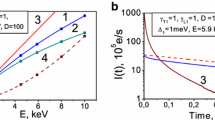The article describes a two-dimensional model of a strip X-ray detector with a superconducting absorbing strip and two tunnel junctions at its ends, The motion of nonequilibrium current carriers (quasiparticles) is considered in the framework of a diffusion equation with boundary conditions of third kind. The detector signals Q l and Q r and the spectral line shape are computed as a function of the strip size, quasiparticle capture efficiency in the tunnel junction, the quasiparticle loss parameter on the absorber lateral boundaries, and the quasiparticle recombination parameter R. Analytical solutions for the detector signals Q l and Q r are derived for the case R = 0 . Numerical calculations are generally used. When boundary and recombination losses are allowed for, the detector signals turn out to depend on the photon absorption coordinate in the transverse direction. This broadens and distorts the spectral line shape.
Similar content being viewed by others
References
S. Friedrich, “Superconducting tunnel junction photon detectors: theory and application,” J. Low Temp. Phys., 151, 277–286 (2008).
P. Verhoeve, D. D. E. Martin, R. A. Hijmering, J. Verveer, A. van Dordrecht, G. Sirbi, T. Oosterbroek, and A. Peacock, “S-Cam 3: Optical astronomy with a STJ-based imaging spectrophotometer,” NIM Phys. Res. A, 559, 598 (2006).
V. A. Andrianov, V. P. Gor’kov, V. P. Koshelets, and L. V. Filippenko, “Superconducting tunnel X-ray detectors. Issues of energy resolution,” Fiz. Tekhn. Poluprovodnikov, 41, No. 2, 221–228 (2007).
H. Kraus , F. von Feilitzsch, J. Jochum, R. L. Mossbauer, T. Peterreins, and F. Probst, ”Quasiparticle trapping in a superconductive detector system exhibiting high energy and position resolution,” Phys. Let. B, 231, 195–202 (1989).
R. A. Hijmering, P. Verhoeve, D. D. E. Marin, A. Peacock, A. G. Kozorezov, and R. Venn, “Imaging spectroscopy with Ta/Al DROIDs: Performance for different absorber lengths,” NIM Phys. Res. A, 559, 692–694 (2006).
J. Jochum, H. Kraus, M. Gutsche, B. Kemmather, F. von Feilitzsch, and P. L. Mossbauer, “Dynamics of radiation induced quasiparticles in superconducting tunnel junction detectors,” Annalen der Physik, 2, 611–634 (1993).
M. Ejrnaes, C. Nappi, and R. Cristiano, “Dynamics of nonequilibrium quasiparticles in a double superconducting tunnel junction detector,” Supercond. Sci. Technol., 18, 953–960 (2005).
A. N. Tikhonov and A. A. Samarskii, Methods of Mathematical Physics [in Russian], Nauka, Moscow (1972).
A. A. Samarskii and V. B. Andreev, Difference Methods for Elliptical Equations [in Russian], Nauka, Moscow (1976).
V. A. Andrianov and V. P. Gor’kov, “Diffusion model of a superconductor junction detector,” Prikl. Matem. Informatika, No. 19, 5–20 (2004).
Author information
Authors and Affiliations
Corresponding author
Additional information
Translated from Prikladnaya Matematika i Informatika, No. 36, pp. 25–35, 2010.
Rights and permissions
About this article
Cite this article
Gor’kov, V.P., Andrianov, V.A. Two-dimensional model of a strip detector with two tunnel junctions. Comput Math Model 23, 14–22 (2012). https://doi.org/10.1007/s10598-012-9113-6
Published:
Issue Date:
DOI: https://doi.org/10.1007/s10598-012-9113-6




